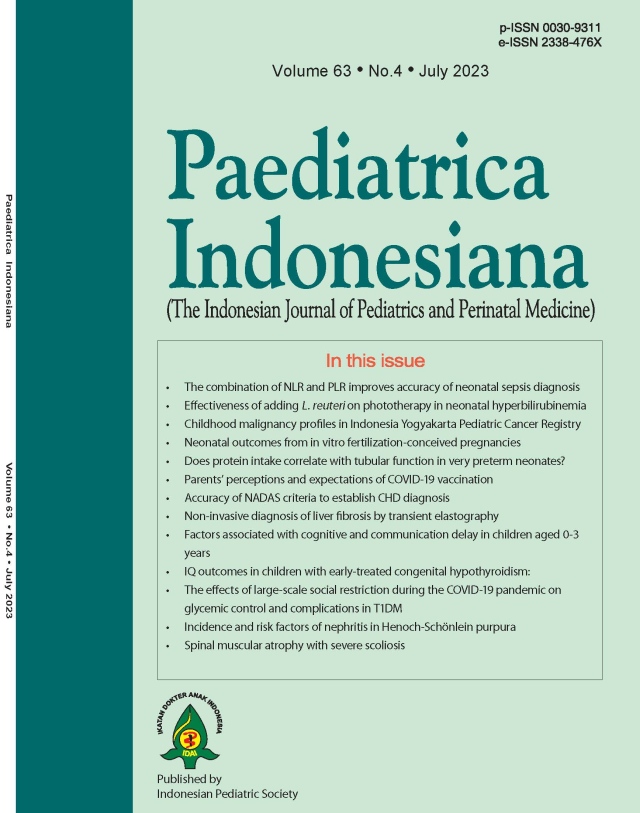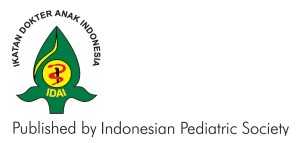Factors associated with cognitive and communication delay in children aged 0 to 3 years using the Battelle-Developmental Inventory, 2nd edition
Abstract
Background The first years of life are crucial in cognitive and communication development. Delayed functional development impedes children’s future academic and occupational performance. Therefore, early detection is important for effective resolution in order to minimize further impairment.
Objective To evaluate cognitive and communication developmental delay in children under 3 years of age in Jakarta using the Battelle Developmental Inventory, 2nd edition (BDI-2).
Methods A cross-sectional study was conducted in Jakarta in 2020, including children aged under 3 years of age without chronic medical conditions that hinder cognitive and speech function. We collected subjects’ demographic characteristics, evaluated their communication and cognitive development using the BDI-2, and analyzed for risk factors of delays.
Results Of 121 children, 34 (28.1%) had cognitive delay and 21 (17.4%) had communication delay. Bivariate analysis revealed that male gender (P=0.048) and non-exclusive breastfeeding (P=0.003) were significantly associated with communication delay, while only male gender was associated with cognitive delay (P=0.015). Multivariate analysis revealed that significant risk factors for communication delay were male gender (P=0.043) and non-exclusive breastfeeding (P=0.023).
Conclusion Male gender and non-exclusive breastfeeding are significant risk factors for delayed communication development, and only male gender was a significant risk factor for cognitive delay. Socioeconomic status, primary caregiver, and breastfeeding duration, were not found to be risk factors for delays.
References
2. Anggraini W. Keterlambatan bicara (speech delay) pada anak (studi kasus anak usia 5 tahun) [thesis]. [Semarang]: Universitas Negeri Semarang; 2011.
3. Kolb B, Fantie BD. Development of the child’s brain and behavior. In: Reynolds CR, Fletcher-Janzen E, editors. Handbook of clinical child neuropsychology. 3rd ed. New York: Springer; 2009. p. 813.
4. MAL-ED Network Investigators. Early childhood cognitive development is affected by interactions among illness, diet, enteropathogens and the home environment: findings from the MAL-ED birth cohort study. BMJ Global Health. 2018;3:e000752. DOI: https://doi.org/10.1136/bmjgh-2018-000752.
5. Simms MD. Language development and communication disorders. Kliegman RM, Stanton BF, St. Geme J, Schor NF. Nelson textbook of pediatrics. 20th ed. Philadelphia: Elsevier; 2016. p. 207-16.
6. Gunawan G. Gambaran perkembang bicara dan bahasa anak usia 0-3 tahun. Sari Pediatri. 2011;13:5. DOI: https://doi.org/10.14238/sp13.1.2011.21-5.
7. Beyeng R, Soetjiningsih, Windiani T. Prevalensi dan karakteristik keterlambatan bicara pada anak prasekolah di TPA Werdhi Kumara I dengan Early Language Milestone Scale-2. J Ilmu Kesehatan Anak. 2012;1:13-6.
8. Zhamaroh LAN, Suhartono S, Nugraheni SA. Analisis faktor yang berhubungan dengan perkembangan kognitif balita umur 2-3 tahun di wilayah Puskesmas leyangan Kabupaten Semarang. J Manajemen Kesehatan Indonesia. 2018;6:8. DOI: https://doi.org/10.14710/jmki.6.3.2018.171-178.
9. Silva PA, Williams S, McGee R. A longitudinal study of children with developmental language delay at age three: later intelligence, reading and behaviour problems. Dev Med Child Neurol. 1987;29:630-40. DOI: https://doi.org/10.1111/j.1469-8749.1987.tb08505.x.
10. Busari JO, Weggelaar NM. How to investigate and manage the child who is slow to speak. BMJ. 2004;328:272-6. DOI: https://doi.org/10.1136/bmj.328.7434.272.
11. Simangunsong SW, Machfudz S, Sitaresmi MN. Accuracy of the Indonesian child development pre-screening questionnaire. Paediatrica Indonesiana. 2012;52:4. DOI: https://doi.org/10.14238/pi52.1.2012.6-9.
12. Elbaum B, Gattamorta KA, Penfield RD. Evaluation of the Battelle Developmental Inventory, 2nd Edition, screening test for use in States’ child outcomes measurement systems under the Individuals With Disabilities Education Act. J Early Intervention. 2010;32:255-73. DOI: https://doi.org/10.1177/1053815110384723.
13. Nuraini ND. Uji validasi pemeriksaan Batelle Development Inventory II versi Indonesia untuk penilaian profil tumbuh kembang anak usia 0-7 tahun 11 bulan. [thesis]. [Jakarta]: Universitas Indonesia;2019.
14. Wani RT. Socioeconomic status scales-modified Kuppuswamy and Udai Pareekh's scale updated for 2019. J Family Med Prim Care. 2019;8:1846-9. DOI: https://doi.org/10.4103/jfmpc.jfmpc_288_19.
15. WHO. WHO child growth standards: training course on child growth assessment. 2008. [cited 2020 Jan 27]. Available from: https://www.who.int/publications/i/item/9789241595070.
16. Indrayan A, Malhotra RK. Medical biostatistics. 4th ed. Florida: Chapman and Hall; 2017. Chapter 19, Simultaneous consideration of several variables; p. 529-53.
17. Mariati LI. Usia dan jenis kelamin dengan kesiapan masuk sekolah dasar Seminar Nasional Spirit Entrepreneurship: menghadapi tantangan MEA. 17 Desember 2016; Gresik: Prosiding Seminar Nasional Psikologi UMG 2017. p. 331.
18. Adani S, Cepanec M. Sex differences in early communication development: behavioral and neurobiological indicators of more vulnerable communication system development in boys. Croat Med J. 2019;60:141-9. DOI: https://doi.org/10.3325/cmj.2019.60.141.
19. Ronfani L, Vecchi Brumatti L, Mariuz M, Tognin V, Bin M, Ferluga V, et al. The complex interaction between home environment, socioeconomic status, maternal IQ and early child neurocognitive development: a multivariate analysis of data collected in a newborn cohort study. PLoS One. 2015;10:e0127052. DOI: https://doi.org/10.1371/journal.pone.0127052.
20. Atika AN, Rasyid H. Dampak status sosial ekonomi orang tua terhadap keterampilan sosial anak. Pedagogia. 2018;7:10. DOI: https://doi.org/10.21070/pedagogia.v7i2.1601.
21. Putri DFTP, Kusbaryanto. Perbedaan hubungan antara ibu bekerja dan ibu rumah tangga terhadap tumbuh kembang anak usia 2-5 tahun. Mutiara Medika. 2012;12:143-9. DOI: https://doi.org/10.18196/mmjkk.v12i3.1032.
22. Zakaria MRA. Pengalihan peran sementara pengasuhan anak dari orang tua ke nenek dan kakek. Jurnal Sosiologi Dialektika. 2020:14:120-5. DOI: https://doi.org/10.20473/jsd.v14i2.2019.120-125.
23. Suparmiati A, Ismail D, Sitaresmi MN. Hubungan ibu bekerja dengan keterlambatan bicara pada anak. Sari Pediatri. 2013;14:4. DOI: https://doi.org/10.14238/sp14.5.2013.288-91.
24. Tan S, Mangunatmadja I, Wiguna T. Risk factors for delayed speech in children aged 1-2 years. Paediatrica Indonesiana. 2019;59:55-62. DOI: https://doi.org/10.14238/pi59.2.2019.55-62.
25. Gunawan G, Fadlyana E, Rusmil K. Hubungan status gizi dan perkembangan anak usia 1 - 2 tahun. Sari Pediatri. 2011;13:5. DOI: https://doi.org/10.14238/sp13.2.2011.142-6.
26. Silva GMD, Couto MIV, Molini-Avejonas DR. Risk factors identification in children with speech disorders: pilot study. Codas. 2013;25:456-62. DOI: https://doi.org/10.1590/S2317-17822013000500010
27. Campbell TF, Dollaghan CA, Rockette HE, Paradise JL, Feldman HM, Shriberg LD, et al. Risk factors for speech delay of unknown origin in 3-year-old children. Child Dev. 2003;74:346-57. DOI: https://doi.org/10.1111/1467-8624.7402002.
28. Sidhu M, Malhi P, Jerath J. Early language development in Indian children: a population-based pilot study. Ann Indian Acad Neurol. 2013;16:371-5. DOI: https://doi.org/10.4103/0972-2327.116937.
29. Deoni S, Dean D, Joelson S, O'Regan J, Schneider N. Early nutrition influences developmental myelination and cognition in infants and young children. Neuroimage. 2018;178:649-59. DOI: https://doi.org/10.1016/j.neuroimage.2017.12.056. .
30. Choi HJ, Kang SK, Chung MR. The relationship between exclusive breastfeeding and infant development: a 6- and 12-month follow-up study. Early Hum Dev. 2018;127:42-7. DOI: https://doi.org/10.1016/j.earlhumdev.2018.08.011.
31. Deoni SCL, Dean DC, Piryatinsky I, O'Muircheartaigh J, Waskiewicz N, Lehman K, et al. Breastfeeding and early white matter development: a cross-sectional study. Neuroimage. 2013;82:77-86. DOI: https://doi.org/10.1016/j.neuroimage.2013.05.090.
Copyright (c) 2023 Florentina Febrina, Veronika Cendana Pinasthika Lawalata, Yetty Ramli

This work is licensed under a Creative Commons Attribution-NonCommercial-ShareAlike 4.0 International License.
Authors who publish with this journal agree to the following terms:
Authors retain copyright and grant the journal right of first publication with the work simultaneously licensed under a Creative Commons Attribution License that allows others to share the work with an acknowledgement of the work's authorship and initial publication in this journal.
Authors are able to enter into separate, additional contractual arrangements for the non-exclusive distribution of the journal's published version of the work (e.g., post it to an institutional repository or publish it in a book), with an acknowledgement of its initial publication in this journal.

This work is licensed under a Creative Commons Attribution-NonCommercial-ShareAlike 4.0 International License.
Accepted 2023-08-14
Published 2023-08-14












